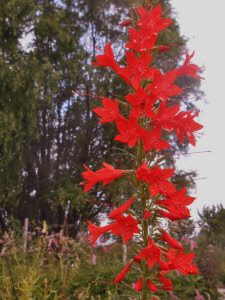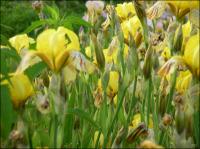Archives
Showing 97–104 of 199 results
-
Hypericum calycinum St. John’s Wort, Aaron’s beard, Rose of Sharon Z 5-9
Showy yellow saucers with prominent stamens
ARCHIVED
Note: This is a plant not currently for sale. This is an archive page preserved for informational use.
Showy yellow saucers with prominent stamens July – Sept, that part of the summer when the early flush of flowers has gone.
Size: 6-12” x indefinite - great groundcover
Care: sun to part shade in moist well-drained soil
Native: Bulgaria and Turkey
Awards: Missouri Botanical Garden Plant of Merit1st collected by George Wheeler on a trip to Constantinople, now Istanbul, in early 1700’s
-
Hypericum polyphyllum ‘Grandiflorum’ Dwarf St.John’s wort Z 5-9
mounds smothered in golden sunbursts
ARCHIVED
Note: This is a plant not currently for sale. This is an archive page preserved for informational use.
Dwarf shrubby mounds smothered in golden sunbursts June – August. Drought tolerant. Perfect for rock, railroad and fairy gardens.
Size: 8” x 6”
Care: sun to part shade in well-drained soil. Cut back after blooming for repeat.
Native: south-east Europe to Asia MinorIn gardens by 1753. Wm. Robinson (1933 ed. English Flower Garden) considered this the best St. John’s Wort: “…one of the largest flowered kinds… It is known by its very glaucous foliage and erect single stems, with bright yellow flowers about 2” across. It forms handsome specimens that flower early, and its value as a choice border plant can scarcely be overrated.”
-
Ilex decidua Possumhaw, Yaupon, Meadow holly Z 5-9
The beauty is in the berries, orange-red berries ripen in September and persist throughout the winter to dazzle the landscape, until mid-March when new growth begins on this small, deciduous tree.
ARCHIVED
Note: This is a plant not currently for sale. This is an archive page preserved for informational use.
The beauty is in the berries, orange-red berries ripen in September and persist throughout the winter to dazzle the landscape, until mid-March when new growth begins on this small, deciduous tree.
Size: 10-15’ x 10-15’
Care: sun to part-shade in acidic, moist to moist well-drained soil, OK in clay
Native: SE & Central US
Wildlife Value: The fruit attracts birds, deer and some small mammals, including opossums, but is poisonous to people.
Awards: Oklahoma Proven 2001Described in literature in 1788.
Dave’s Garden: The origin of common name holly dates back to the 11th century, where the German word hulis and Old English term holegn both refer to holly. Then as now, the Gaelic term for holly is cuileann.**LISTED AS OUT OF STOCK BECAUSE WE DO NOT SHIP THIS ITEM. IT IS AVAILABLE FOR PURCHASE AT OUR RETAIL LOCATION.
-
Ipomopsis rubra Standing Cypress, Scarlet Gilia Z 5-9 Biennial
Red-orange trumpet-shaped blooms encircle 3-5’ tall spike from May-July
ARCHIVED
Note: This is a plant not currently for sale. This is an archive page preserved for informational use.
Red-orange trumpet-shaped blooms encircle 3-5’ tall spike from May-July
Size: 3-5’ x 3-6’
Care: sun in dry to moist, well-drained soil
Native: Oklahoma-South Carolina, Florida to Texas
Wildlife Value: attracts bees, Swallowtail butterflies and hummingbirds. Deer resistant.Described by Linnaeus in Species Plantarum 1: 163. 1753
-
Iris ‘Honorabile’ Z 4-9
Clear yellow standards with maroon striped-dashed falls
ARCHIVED
Note: This is a plant not currently for sale. This is an archive page preserved for informational use.
Clear yellow standards with maroon striped-dashed falls, blooms in mid-season
Size: 18-24" x 12"
Care: sun in moist well-drained soilFrench hybrid by Nicolas Lemon in 1840’s.
-
Iris ensata syn. Iris kaempferi Japanese iris. Called Hana-shôbu in Japan Z. 5-8
White to reddish purple flowers with no beards (no standard, rising up) and have rhizomes all below ground.
ARCHIVED
Note: This is a plant not currently for sale. This is an archive page preserved for informational use.
White to reddish purple flowers with no beards (no standard, rising up) and have rhizomes all below ground.
Size: 2-3' x 9”
Care: moist acidic soil in full sun
Native: China, Korea and Japan
Wildlife Value: attracts hummingbirds, bees and butterflies. Deer and rabbit resistant.
Awards: England’s Royal Horticultural Society Award of Merit.Grown in Japanese gardens for at least 1200 years (since 8th century) as a marginal aquatic plant. A symbol for beautiful women and used to dye fabric. Introduced to the west in 1690’s by Englebert Kaempfer, physician to Dutch East India Co. on Deschema Island, off the coast of Japan. “The Garden” May 20, 1876: “For many of the siebold, German botanist (most beautiful varieties we are indebted to Dr. von Siebold, the celebrated German botanist, at Leyden.” Von Siebold (1796-1866).
-
Iris tectorum Japanese roof iris, Wall iris, Root iris Z 5-9
In late spring violet flowers, with purple highlights, bloom above the flat, low fans of wide leaves
ARCHIVED
Note: This is a plant not currently for sale. This is an archive page preserved for informational use.
In late spring violet flowers, with purple highlights, bloom above the flat, low fans of wide leaves. It spreads into dense clumps. Rhizomes are poisonous.
Size: 12-14” X 3’
Care: sun to part shade in moist well-drained to well-drained soil
Native: Japan & Central & SW ChinaFor Japanese, a triple hitter. Women powdered rhizomes for their faces. Since at least the 7th century, Japanese grew this on their thatched roofs. It helped hold the thatching together. Folk lore also claimed it warded off evil spirits. 1st described for the West in 1871, Bulletin de l’Academie Imperiale des Sciences de St-Petersbourg.
-
Jasione montana syn J. laevis Sheep’s bit Scabious BIENNIAL Z 5-8
Globes of small blue flowers in July-August
ARCHIVED
Note: This is a plant not currently for sale. This is an archive page preserved for informational use.
Globes of small blue flowers in July-August
Size: 12” x 8”
Care: full sun in well-drained soil.
Native: Europe and Russia
Wildlife Value: attracts bees, butterflies and many other pollinators.Described by Linnaeus 1753







